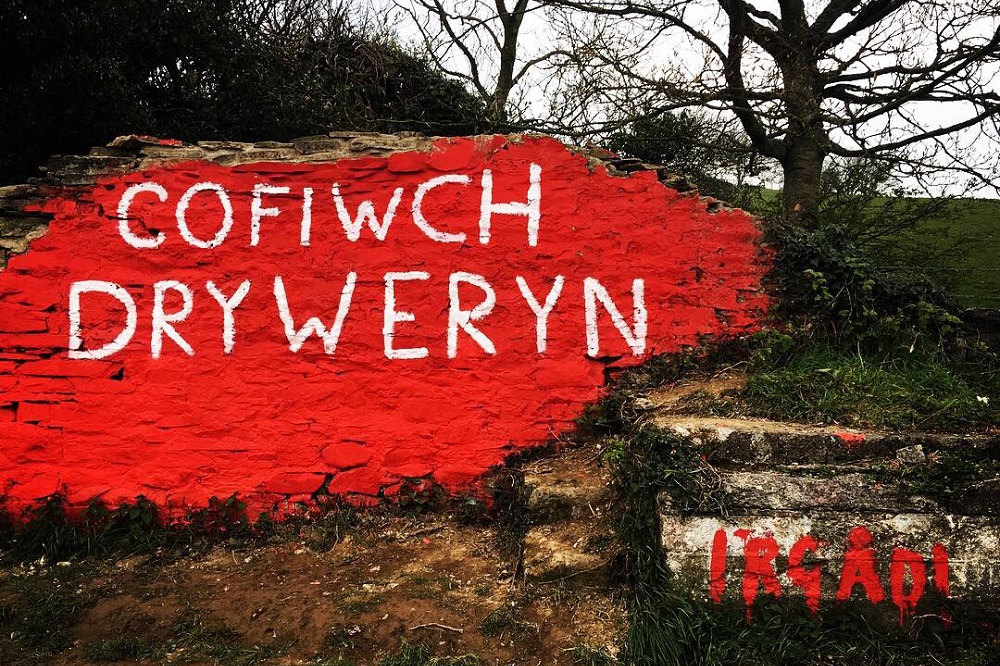Why the Tryweryn mural matters

Gareth Ceidiog Hughes
The Tryweryn mural isn’t just any old graffiti on a wall.
It’s rather more significant than ‘Dave luvz Brenda’ scrawled on a park bench in marker pen. Not that I would for one moment doubt the depth of feeling Dave has for Brenda of course. But the impact of that on the nation is a tad limited.
There are those who mock, sneer at and demean those who took the time and the effort to restore the Tryweryn mural after it was vandalised. They are the blind who make fun of those who can see.
Some of them may just about understand the awfulness of Tryweryn. They may not think that the drowning of Capel Celyn and the destruction of a purely Welsh-speaking village was a good thing.
But to them the Tryweryn mural is no different to any other wall with graffiti on it. They don’t fully grasp what it represents and why it means so much to so many people.
There aren’t many worse feelings than helplessness, of powerlessness. The cultural vandalism in the Tryweryn Valley was a moment of national helplessness.
It’s not as if the people of Wales did not stand up to be counted. There were protests. Wales’ MPs overwhelmingly voted against the Act of Parliament that allowed a community to be destroyed.
However, it made no difference. Ultimately, they were powerless; overwhelmed by brute force. Men, women and children were uprooted from their homes. The bulldozers rolled in and turned what were once homes into rubble. The theft of our resources was legalised, and it continues to be legal to this day.
The year was 1965. The percentage of Welsh speakers in Wales was in freefall. The gushing wound caused by centuries of anti-Welsh language state policy was grievous, wide and deep.
Welsh speakers were being haemorrhaged at an alarming rate. It looked like the language might not survive. The end seemed nigh.
Renew
But that was not the end of the story. It was the beginning of a fightback. The visceral realisation of powerlessness created a determination to take back the power to defend our communities and the culture they incubate and engender.
It sparked a determination in Welsh speakers, especially, to fight for linguistic rights. Many of those rights have been won. Welsh speakers now have the right to access public services in the language.
We now have S4C and BBC Radio Cymru. Welsh medium education is being expanded.
It also reignited the battle for Welsh autonomy. We now have our own Senedd. These things matter.
Cofiwch Dryweryn (Remember Tryweryn) is a battle cry. That battle cry was heard and acted upon. An army of activists charged the lines of discrimination, bigotry, and arrogant dismissal damaging the language. The mural captured the zeitgeist. It captured the mood of a nation.
It was created by the writer and academic Meic Stephens, the father of Radio 1 DJ Huw Stephens. Though he made an enormous contribution to Welsh literature he said that nothing had as profound an impact on the popular imagination as the Cofiwch Dryweryn mural.
The white letters on the blood-red background, the red of the dragon, the red of Wales, symbolise an act of defiance; a readiness to stand up and be counted. Each time it is renewed it renews our sense of pride, our sense of defiance, and our determination to keep our heads unbowed.
It should not have to be renewed of course. The reason it needs to be is that the fight for the Welsh language is far from over. Hateful and dismissive colonial attitudes towards it still exist and poison our land.
Though it is undoubtedly iconic, there aren’t many people who would claim it’s a piece of artistic beauty. It ain’t no Picasso or Rembrandt. Anyone who criticises it on those grounds couldn’t miss the point more spectacularly if they tried.
In a way, its very ordinariness is its power. It shows us that we all have the power to defend our language, culture, and heritage. That’s what enabled committed young people to restore, renew and revitalise it each time it was vandalised by mindless and hateful idiots.
That’s why new murals are popping up all over Wales; a powerful riposte to those who wish to demean and destroy our culture. We can all make a contribution. We all have the power to inspire.
Our rights are not set in stone. They could still be taken away. The number of Welsh speakers in Wales has stabilised to a degree. But the future of the language is not yet secure.
The language is still at a structural disadvantage as a result of centuries of anti-Welsh policies and propaganda.
That is why we must Remember Tryweryn.
Cofiwch Dryweryn reminds us that what is precious to us can be lost forever if we don’t have the power to defend it, and that it’s worth fighting for.
We can’t run Nation.Cymru without your help! If you support the development of an independent Welsh media for the people of Wales, please donate now!
Support our Nation today
For the price of a cup of coffee a month you can help us create an independent, not-for-profit, national news service for the people of Wales, by the people of Wales.




